Where to buy V-Ampire LX112?
Less
There are no classified ads for this product.
Tech. sheet
- Manufacturer: Behringer
- Model: V-Ampire LX112
- Series: V-Ampire
- Category: Modelling Combo Guitar Amps
- Other names:v ampirelx112, vampirelx112, v ampire lx 112, LX112, LX 112
We have no technical specifications for this product
but your help will be much welcomed
»
User reviews
4.8/5(10 reviews)
5
90 %
4
10 %
3
2
1
Behringer V-Ampire (LX-1)
Published on 10/14/03 at 15:00Purchased the V-Ampire from Music Unlimited in San Leandro, CA. I know it's doubtful that anyone from the old neighborhood is reading this, but in case you are and haven't been to MU in awhile, it's no longer "Music Unreasonable". They actually sell stuff for the same price as GC or Musician's Friend now. Price paid: $299.00
(I reviewed Behringer's V-Amp Pro on other sites and the V-Ampire is identical to it except for being a complete combo amp instead of just the modeler, so I'm excerpting a lot of what I've already written)
As far as modeling and signal processing goes, this is about as easy as it gets. For the dyed-in-the-wool knob twiddlers, this is probably a bad thing....…
(I reviewed Behringer's V-Amp Pro on other sites and the V-Ampire is identical to it except for being a complete combo amp instead of just the modeler, so I'm excerpting a lot of what I've already written)
As far as modeling and signal processing goes, this is about as easy as it gets. For the dyed-in-the-wool knob twiddlers, this is probably a bad thing....…
Read more
Purchased the V-Ampire from Music Unlimited in San Leandro, CA. I know it's doubtful that anyone from the old neighborhood is reading this, but in case you are and haven't been to MU in awhile, it's no longer "Music Unreasonable". They actually sell stuff for the same price as GC or Musician's Friend now. Price paid: $299.00
(I reviewed Behringer's V-Amp Pro on other sites and the V-Ampire is identical to it except for being a complete combo amp instead of just the modeler, so I'm excerpting a lot of what I've already written)
As far as modeling and signal processing goes, this is about as easy as it gets. For the dyed-in-the-wool knob twiddlers, this is probably a bad thing. Relatively speaking, you have very little control over what goes on here in terms of parameter tweaking. There's more than enough where the tone-shaping controls are concerned, but not with the effects/cab sims. For time-based effects you can adjust the tempo of delays and the speed for chorus/flange/phase/rotary, along with the dry/wet ratio, but that's about it. You cannot combine effects at will (although I understand with the downloadable software you have much more flexibility), you can't select where they appear in the chain, and you have no control over parameters like pre-delay or early reflections or any number of other factors like you would in a dedicated effects processor. Likewise, with the cabinet sims, you cannot determine mike placement or miked/direct levels.
This is NOT a criticism of this unit. In fact it is one of things I most appreciate about it. I'm one of those people seriously afflicted with a condition known as, "Option Anxiety". Being faced with too many options for tone modification will usually cause me to put my guitar down and go find something else to do with my time. "Let's see, maybe if I roll off some low end, boost the mids and highs, then add a taste of flange with some delay, I'll get that sound I'm after. But wait, maybe I need more low end, and what if I flange the distortion rather than distorting the flange and go with echo rather than delay, then maybe add just a touch of pitch shift . . ." I HATE TRYING TO DIAL IN GUITAR TONES!!!!!!!!!!!!!!!!!!!!! I just want to plug 'n' play and with the V-Ampire, I can.
I really have no complaints about the V-Ampire, but there are a few common complaints about Behringer. Mostly it has to do with their documentation. They have this nasty habit of making things sound much more difficult than they really are. I don't know if it's a translation problem or what, but the manuals definitely have the ability to confuse. Another thing about the documentation is it's never complete. The manuals make reference to sections and inserts that don't exist in the owner's manual. A quick trip to www.behringer.com will solve that because it's all there to be downloaded.
One final common complaint regarding Behringer modelers, and this isn't a problem for me, has to do with patch changes. There is a noticeable lag or pause between some patches. I believe this has to do with the processor speed and horsepower and so is inherent in the design. A lot of manufacturers have overcome this, and perhaps Behringer will too (I understand they're pretty good when it comes to upgrades). The lag or pause is evident when changing between patches that use different amp models. When switching between those that use the same amp sim (even with everything else being completely different), there is no perceptible lag time.
Weighing everything against what the purchase price is, I'd have to say that the build quality of all Behringer gear is pretty darned impressive. Cosmetically, the V-Ampire is easy on my eye. It's got kind of an updated blackface vibe going on (with a lot more buttons and LEDs, of course). A close examination will show where the cost cuts were. The hardware is not as heavy duty as you'll find on more expensive amps. The cabinet, while apparently sturdy, is not as chunky as you'll find elsewhere and the grill cloth on my V-Ampire is a little 'wrinkly' and looks like it could tear more easily than some. All things considered, though I think this is as good a quality as you can expect for the money (and probably better than a lot of alternatives in this price range).
WARNING! I'm gonna let out some shaft and turn the 'RANT' knob up to '11', so if any of you are sensitive to the 100% subjective, unadulterated opinions of others then hit your browsers 'back' button now . . .
Let's talk about amp modeling in general. In my opinion, the biggest error you can commit when checking ANY of this stuff out is using your eyes to read the amp list instead of your ears to hear what sounds are coming out of the machine. I'll use an example from one of the V-Ampire's presets:
6B-"Eddie's Tapping". If you plug in and access this preset, are you gonna hear 'Eruption' coming back out at you? Nope. Why? It's obvious isn't it? A) You don't have Eddie's fingers. B) You don't have Ted Templeman's ears. C) You don't have Donn Landee's engineering chops. Furthermore, even if the Tone Fairy somehow magically whisked you away to the actual recording sessions for VH's first album, and Eddie handed his guitar off to you, without changing a single thing in his setup, you wouldn't sound any more like him than a dump truck being dropped off the Empire State Building. I'm not being an A-hole, because I'm including myself here. VH is a better guitar player with his asscheeks than I'll ever be with all ten fingers (and toes for that matter), it's just a fact that one man's meat can be another man's poison and it's always the player that makes the biggest difference.
Another thing is, unless you own or have owned a 60's Plexi, do you REALLY know what one sounds like? And the boutique stuff? Forget about it. I've been in a LOT of music stores over the last 30 years and I've never even seen a picture of a Dumble Overdrive let alone heard one. I wouldn't know one if it fell on my head. My point is, just disregard what kind of amps the manufacturer says they're modeling. Just play the damn thing and if it sounds good to you and you can get some use out of the tones, then it doesn't matter if it's supposed to be a Budda Twinmaster, a vintage Fender Bassman, or a Pennsyltucky Sooper Dooper Quadruple Rectal-fire.
Originally, I bought the V-Amp Pro and got it exclusively for going direct to a mixer then to a digital recorder (just like a ton of other stuff from BOSS, Digitech, Yamaha, Korg, etc. etc.). After hearing how good it sounded, I ended up returning it for the V-Ampire since they're identical except for the fact that the V-Ampire is a complete combo amp. After getting that home and hearing how good IT sounded, I went back and bought a Behringer B412S stereo cabinet (all my 4X12s are mono). My guitars are either Les Pauls, or LP-inspired guitars by Gibson, Heritage and Hamer, although I ocassionally play an Ibanez S-Type WRM520S, and they all sound good with the V-Ampire. For me, the V-Ampire has some quality sounds built into it. I've gotten some very satisfying clean and crunch tones out of it. There are some fat, sparkly, warm and dimensional clean sounds available, and some of the dirtier tones are surprisingly articulate, fairly responsive, and slightly more tube-like than transistor-like. The effects, though not breathtaking, work very well with the other components. But again, if you're used to dedicated, high-end effects processors with a lot of parameter control, this could be disappointing for you. The unit has been for the most part, noise-free and the gate works very well.
And finally on the 'My Amp Can Kick Your Amp's Ass' nonsense that goes on in chat rooms, bulletin boards, and review websites. To quote Brother Rodney, "Can't we all just get along?" Where modeling technology is concerned, I think objectively it's safe to say that there's nothing out there as real as the 'real thing' and probably not as good if one were being honest. I mean think about it for a minute. If Behringer, Line 6, Johnson, and the rest of the modeling manufacturers made amps that were superior tone generators, then Marshall, Boogie, Fender and everyone else would be trying to emulate their sound instead of the other way around. I know from first hand experience that there's nothing like being on stage in front of a stack of amps and driving them to the point where the tubes nearly liquify, but I also know the practical considerations of home recording and small club gigs, and this to me is where modeling technology can take a real bite out of the big boy's collective asses.
Over the last 30 years I have played mostly Melodic Rock, Hard Rock, Old-School Progressive Rock and Old-School Metal and done it through Marshall, Hi-Watt, Orange, Fender, Peavey, L7, and Mesa/Boogie (at a time when they could have been considered 'boutique'). The V-Ampire has been compatible with a lot of the music I'm into and has proven to be a very useful tool for recording which is what I bought it for primarily. Behringer's line of modelers invites the inevitable comparison to Line 6 and rightfully so. Nothing against Line 6, but their stuff usually costs two or three times as much as Behringer's and there's no way you could convince me that Line 6 is worth the price difference for essentially identical pieces of equipment. But if you like Line 6, then that's alright with me and we can still be friends.
Is the V-Ampire as good as having a stable of real (vs. virtual)amplifiers? No. Are the effects as good as anything from T.C. Electronics, Lexicon, or Eventide? No. Are you really gonna get a Dumble Overdrive for $299 instead of $12,000? F*ck NO.
Are you gonna get a hell of a lot of bang for your buck? Yeah, you are.
Even though this is far, far away from the ultimate tone generator (as is every other SINGLE piece of gear on earth, in my opinion), based on that old Value-to-Dollar Ratio, I gotta give this little combo a 10 on the 5-scale.
This review was originally published on http://www.musicgearreview.com
(I reviewed Behringer's V-Amp Pro on other sites and the V-Ampire is identical to it except for being a complete combo amp instead of just the modeler, so I'm excerpting a lot of what I've already written)
As far as modeling and signal processing goes, this is about as easy as it gets. For the dyed-in-the-wool knob twiddlers, this is probably a bad thing. Relatively speaking, you have very little control over what goes on here in terms of parameter tweaking. There's more than enough where the tone-shaping controls are concerned, but not with the effects/cab sims. For time-based effects you can adjust the tempo of delays and the speed for chorus/flange/phase/rotary, along with the dry/wet ratio, but that's about it. You cannot combine effects at will (although I understand with the downloadable software you have much more flexibility), you can't select where they appear in the chain, and you have no control over parameters like pre-delay or early reflections or any number of other factors like you would in a dedicated effects processor. Likewise, with the cabinet sims, you cannot determine mike placement or miked/direct levels.
This is NOT a criticism of this unit. In fact it is one of things I most appreciate about it. I'm one of those people seriously afflicted with a condition known as, "Option Anxiety". Being faced with too many options for tone modification will usually cause me to put my guitar down and go find something else to do with my time. "Let's see, maybe if I roll off some low end, boost the mids and highs, then add a taste of flange with some delay, I'll get that sound I'm after. But wait, maybe I need more low end, and what if I flange the distortion rather than distorting the flange and go with echo rather than delay, then maybe add just a touch of pitch shift . . ." I HATE TRYING TO DIAL IN GUITAR TONES!!!!!!!!!!!!!!!!!!!!! I just want to plug 'n' play and with the V-Ampire, I can.
I really have no complaints about the V-Ampire, but there are a few common complaints about Behringer. Mostly it has to do with their documentation. They have this nasty habit of making things sound much more difficult than they really are. I don't know if it's a translation problem or what, but the manuals definitely have the ability to confuse. Another thing about the documentation is it's never complete. The manuals make reference to sections and inserts that don't exist in the owner's manual. A quick trip to www.behringer.com will solve that because it's all there to be downloaded.
One final common complaint regarding Behringer modelers, and this isn't a problem for me, has to do with patch changes. There is a noticeable lag or pause between some patches. I believe this has to do with the processor speed and horsepower and so is inherent in the design. A lot of manufacturers have overcome this, and perhaps Behringer will too (I understand they're pretty good when it comes to upgrades). The lag or pause is evident when changing between patches that use different amp models. When switching between those that use the same amp sim (even with everything else being completely different), there is no perceptible lag time.
Weighing everything against what the purchase price is, I'd have to say that the build quality of all Behringer gear is pretty darned impressive. Cosmetically, the V-Ampire is easy on my eye. It's got kind of an updated blackface vibe going on (with a lot more buttons and LEDs, of course). A close examination will show where the cost cuts were. The hardware is not as heavy duty as you'll find on more expensive amps. The cabinet, while apparently sturdy, is not as chunky as you'll find elsewhere and the grill cloth on my V-Ampire is a little 'wrinkly' and looks like it could tear more easily than some. All things considered, though I think this is as good a quality as you can expect for the money (and probably better than a lot of alternatives in this price range).
WARNING! I'm gonna let out some shaft and turn the 'RANT' knob up to '11', so if any of you are sensitive to the 100% subjective, unadulterated opinions of others then hit your browsers 'back' button now . . .
Let's talk about amp modeling in general. In my opinion, the biggest error you can commit when checking ANY of this stuff out is using your eyes to read the amp list instead of your ears to hear what sounds are coming out of the machine. I'll use an example from one of the V-Ampire's presets:
6B-"Eddie's Tapping". If you plug in and access this preset, are you gonna hear 'Eruption' coming back out at you? Nope. Why? It's obvious isn't it? A) You don't have Eddie's fingers. B) You don't have Ted Templeman's ears. C) You don't have Donn Landee's engineering chops. Furthermore, even if the Tone Fairy somehow magically whisked you away to the actual recording sessions for VH's first album, and Eddie handed his guitar off to you, without changing a single thing in his setup, you wouldn't sound any more like him than a dump truck being dropped off the Empire State Building. I'm not being an A-hole, because I'm including myself here. VH is a better guitar player with his asscheeks than I'll ever be with all ten fingers (and toes for that matter), it's just a fact that one man's meat can be another man's poison and it's always the player that makes the biggest difference.
Another thing is, unless you own or have owned a 60's Plexi, do you REALLY know what one sounds like? And the boutique stuff? Forget about it. I've been in a LOT of music stores over the last 30 years and I've never even seen a picture of a Dumble Overdrive let alone heard one. I wouldn't know one if it fell on my head. My point is, just disregard what kind of amps the manufacturer says they're modeling. Just play the damn thing and if it sounds good to you and you can get some use out of the tones, then it doesn't matter if it's supposed to be a Budda Twinmaster, a vintage Fender Bassman, or a Pennsyltucky Sooper Dooper Quadruple Rectal-fire.
Originally, I bought the V-Amp Pro and got it exclusively for going direct to a mixer then to a digital recorder (just like a ton of other stuff from BOSS, Digitech, Yamaha, Korg, etc. etc.). After hearing how good it sounded, I ended up returning it for the V-Ampire since they're identical except for the fact that the V-Ampire is a complete combo amp. After getting that home and hearing how good IT sounded, I went back and bought a Behringer B412S stereo cabinet (all my 4X12s are mono). My guitars are either Les Pauls, or LP-inspired guitars by Gibson, Heritage and Hamer, although I ocassionally play an Ibanez S-Type WRM520S, and they all sound good with the V-Ampire. For me, the V-Ampire has some quality sounds built into it. I've gotten some very satisfying clean and crunch tones out of it. There are some fat, sparkly, warm and dimensional clean sounds available, and some of the dirtier tones are surprisingly articulate, fairly responsive, and slightly more tube-like than transistor-like. The effects, though not breathtaking, work very well with the other components. But again, if you're used to dedicated, high-end effects processors with a lot of parameter control, this could be disappointing for you. The unit has been for the most part, noise-free and the gate works very well.
And finally on the 'My Amp Can Kick Your Amp's Ass' nonsense that goes on in chat rooms, bulletin boards, and review websites. To quote Brother Rodney, "Can't we all just get along?" Where modeling technology is concerned, I think objectively it's safe to say that there's nothing out there as real as the 'real thing' and probably not as good if one were being honest. I mean think about it for a minute. If Behringer, Line 6, Johnson, and the rest of the modeling manufacturers made amps that were superior tone generators, then Marshall, Boogie, Fender and everyone else would be trying to emulate their sound instead of the other way around. I know from first hand experience that there's nothing like being on stage in front of a stack of amps and driving them to the point where the tubes nearly liquify, but I also know the practical considerations of home recording and small club gigs, and this to me is where modeling technology can take a real bite out of the big boy's collective asses.
Over the last 30 years I have played mostly Melodic Rock, Hard Rock, Old-School Progressive Rock and Old-School Metal and done it through Marshall, Hi-Watt, Orange, Fender, Peavey, L7, and Mesa/Boogie (at a time when they could have been considered 'boutique'). The V-Ampire has been compatible with a lot of the music I'm into and has proven to be a very useful tool for recording which is what I bought it for primarily. Behringer's line of modelers invites the inevitable comparison to Line 6 and rightfully so. Nothing against Line 6, but their stuff usually costs two or three times as much as Behringer's and there's no way you could convince me that Line 6 is worth the price difference for essentially identical pieces of equipment. But if you like Line 6, then that's alright with me and we can still be friends.
Is the V-Ampire as good as having a stable of real (vs. virtual)amplifiers? No. Are the effects as good as anything from T.C. Electronics, Lexicon, or Eventide? No. Are you really gonna get a Dumble Overdrive for $299 instead of $12,000? F*ck NO.
Are you gonna get a hell of a lot of bang for your buck? Yeah, you are.
Even though this is far, far away from the ultimate tone generator (as is every other SINGLE piece of gear on earth, in my opinion), based on that old Value-to-Dollar Ratio, I gotta give this little combo a 10 on the 5-scale.
This review was originally published on http://www.musicgearreview.com
See less
00
»
Good value for money
Published on 08/14/12 at 03:53 (This content has been automatically translated from French)What kind of amplification (lamp, transistor, ...)? Power delivered?
transistor 2x60W stereo or mono 1x100W
What connection?
There's everything you need! 3'5 input jack for an mp3 or a PC with volume control input, headphone output on the front, midi interface, speaker outputs, input to output effects loop ...
What are the settings, the effects? ...
This is the same, there what to do with the simultaneous amp, cab, reverb and effects palette, it's pretty full for a wide range of sounds.
UTILIZATION
The configuration is simple?
After careful reading of the manual is fairly simple although not very intuitive for all possible "hidden".
The manual is clear and...…
transistor 2x60W stereo or mono 1x100W
What connection?
There's everything you need! 3'5 input jack for an mp3 or a PC with volume control input, headphone output on the front, midi interface, speaker outputs, input to output effects loop ...
What are the settings, the effects? ...
This is the same, there what to do with the simultaneous amp, cab, reverb and effects palette, it's pretty full for a wide range of sounds.
UTILIZATION
The configuration is simple?
After careful reading of the manual is fairly simple although not very intuitive for all possible "hidden".
The manual is clear and...…
Read more
What kind of amplification (lamp, transistor, ...)? Power delivered?
transistor 2x60W stereo or mono 1x100W
What connection?
There's everything you need! 3'5 input jack for an mp3 or a PC with volume control input, headphone output on the front, midi interface, speaker outputs, input to output effects loop ...
What are the settings, the effects? ...
This is the same, there what to do with the simultaneous amp, cab, reverb and effects palette, it's pretty full for a wide range of sounds.
UTILIZATION
The configuration is simple?
After careful reading of the manual is fairly simple although not very intuitive for all possible "hidden".
The manual is clear and sufficient? ...
I find the manual very clear and quite synthetic not spend hours looking for what you want.
Do you get a good sound easy?
For me yes, starting presets quo'n approaching it seeks it's pretty easy. If not from scratch but it's less obvious in the long run there is!
SOUNDS
Will it fit your style of music?
Yes, I think it fits quite a distinct style of music that sounds are too often for my taste metal ...
What types of sounds you get and with what settings ("crystalline", "fat", ....)?
A little difficult to get clear sounds, there's distortion sounds for something to have fun.
With what (s) guitar (s) do you play?
SG guitar Custom77
What are the sounds you prefer, you hate?
Large distortion and fuzz are not bad, too presets with electronic effects sound great I think.
OVERALL OPINION
To my taste it's a good amp for the price (paid 140 euro for Cygnus new!).
Than enough to repeat it.
The only reason that will make my change of gear is the weight of a combo, 22kg down over 3 floors each repeat I will spend on a head + for firms that do take the head.
transistor 2x60W stereo or mono 1x100W
What connection?
There's everything you need! 3'5 input jack for an mp3 or a PC with volume control input, headphone output on the front, midi interface, speaker outputs, input to output effects loop ...
What are the settings, the effects? ...
This is the same, there what to do with the simultaneous amp, cab, reverb and effects palette, it's pretty full for a wide range of sounds.
UTILIZATION
The configuration is simple?
After careful reading of the manual is fairly simple although not very intuitive for all possible "hidden".
The manual is clear and sufficient? ...
I find the manual very clear and quite synthetic not spend hours looking for what you want.
Do you get a good sound easy?
For me yes, starting presets quo'n approaching it seeks it's pretty easy. If not from scratch but it's less obvious in the long run there is!
SOUNDS
Will it fit your style of music?
Yes, I think it fits quite a distinct style of music that sounds are too often for my taste metal ...
What types of sounds you get and with what settings ("crystalline", "fat", ....)?
A little difficult to get clear sounds, there's distortion sounds for something to have fun.
With what (s) guitar (s) do you play?
SG guitar Custom77
What are the sounds you prefer, you hate?
Large distortion and fuzz are not bad, too presets with electronic effects sound great I think.
OVERALL OPINION
To my taste it's a good amp for the price (paid 140 euro for Cygnus new!).
Than enough to repeat it.
The only reason that will make my change of gear is the weight of a combo, 22kg down over 3 floors each repeat I will spend on a head + for firms that do take the head.
See less
00
»
Published on 03/19/12 at 00:34 (This content has been automatically translated from French)
I will not dwell on a description that has already been the subject of X com.
but the V-Amp I'm looking at is equipped with a HP Jensen JCH 12/70 8homs
everything else is really just the same.
UTILIZATION
RAS
SOUNDS
2 Strat, an Aria pro2, an Epiphone Korina Explorer, a gibson LP ... it adapts to any guitar without problems. all steel ... jazz new orleans except where it is preferable to have a banjo!
OVERALL OPINION
years .. uh! 2004 or by that?
it is a clean amp, without major defects, which can play at home or in repets; in concert ... all is well outside, it will be "transplanted" on the table, but everything is provided for ca ...
to purchase once for having a...…
but the V-Amp I'm looking at is equipped with a HP Jensen JCH 12/70 8homs
everything else is really just the same.
UTILIZATION
RAS
SOUNDS
2 Strat, an Aria pro2, an Epiphone Korina Explorer, a gibson LP ... it adapts to any guitar without problems. all steel ... jazz new orleans except where it is preferable to have a banjo!
OVERALL OPINION
years .. uh! 2004 or by that?
it is a clean amp, without major defects, which can play at home or in repets; in concert ... all is well outside, it will be "transplanted" on the table, but everything is provided for ca ...
to purchase once for having a...…
Read more
I will not dwell on a description that has already been the subject of X com.
but the V-Amp I'm looking at is equipped with a HP Jensen JCH 12/70 8homs
everything else is really just the same.
UTILIZATION
RAS
SOUNDS
2 Strat, an Aria pro2, an Epiphone Korina Explorer, a gibson LP ... it adapts to any guitar without problems. all steel ... jazz new orleans except where it is preferable to have a banjo!
OVERALL OPINION
years .. uh! 2004 or by that?
it is a clean amp, without major defects, which can play at home or in repets; in concert ... all is well outside, it will be "transplanted" on the table, but everything is provided for ca ...
to purchase once for having a front plate, after you can buy a light amp for the show ...
it reminds me a Strato (the Swiss Army Knife necessary) is the lespaul for benefits (the rolls).
but the V-Amp I'm looking at is equipped with a HP Jensen JCH 12/70 8homs
everything else is really just the same.
UTILIZATION
RAS
SOUNDS
2 Strat, an Aria pro2, an Epiphone Korina Explorer, a gibson LP ... it adapts to any guitar without problems. all steel ... jazz new orleans except where it is preferable to have a banjo!
OVERALL OPINION
years .. uh! 2004 or by that?
it is a clean amp, without major defects, which can play at home or in repets; in concert ... all is well outside, it will be "transplanted" on the table, but everything is provided for ca ...
to purchase once for having a front plate, after you can buy a light amp for the show ...
it reminds me a Strato (the Swiss Army Knife necessary) is the lespaul for benefits (the rolls).
See less
00
»
Published on 11/10/03 at 05:19 (This content has been automatically translated from French)
Amp-modeling (32 amps, 16 HP simulation, 16 effects ,...)-
-100 Watts (2 * 50W output Stro)
-About almost everything: XLR, Midi, HP Output, FX Loop, Output Stro, Prampli, Headset ,...)
Rglages them: 1 Master volume, Volume 1, a Gain, Bass 1, 1 Middle, Trebble 1 (the classic ...), what a knob select the amp simulation, a wheel for effects, a button for the tuner Intgr ...
-Footswitch provided that can switch from one preset to another bank.
UTILIZATION
Configuration: rgler can not read the book and get a good sound but for an optimized config, we read the book (ten pages) and can be easily rgler all!
Only small black dot: the footswitch does not switch from one bank to...…
-100 Watts (2 * 50W output Stro)
-About almost everything: XLR, Midi, HP Output, FX Loop, Output Stro, Prampli, Headset ,...)
Rglages them: 1 Master volume, Volume 1, a Gain, Bass 1, 1 Middle, Trebble 1 (the classic ...), what a knob select the amp simulation, a wheel for effects, a button for the tuner Intgr ...
-Footswitch provided that can switch from one preset to another bank.
UTILIZATION
Configuration: rgler can not read the book and get a good sound but for an optimized config, we read the book (ten pages) and can be easily rgler all!
Only small black dot: the footswitch does not switch from one bank to...…
Read more
Amp-modeling (32 amps, 16 HP simulation, 16 effects ,...)-
-100 Watts (2 * 50W output Stro)
-About almost everything: XLR, Midi, HP Output, FX Loop, Output Stro, Prampli, Headset ,...)
Rglages them: 1 Master volume, Volume 1, a Gain, Bass 1, 1 Middle, Trebble 1 (the classic ...), what a knob select the amp simulation, a wheel for effects, a button for the tuner Intgr ...
-Footswitch provided that can switch from one preset to another bank.
UTILIZATION
Configuration: rgler can not read the book and get a good sound but for an optimized config, we read the book (ten pages) and can be easily rgler all!
Only small black dot: the footswitch does not switch from one bank to another preset (this can be corrected with the MIDI pdalier optional)
Otherwise use trs simple.
SOUNDS
All possible sounds, light or the trs trs saturated!
APRS is not the quality of the lamps but has a great sound reproduction all volumes and an infinite palette of sounds.
OVERALL OPINION
I use it for a week, I can not get enough of it!
I can make any sound with it. J'apprcie can register directly into my sound card (all rotten but good) and does not look bad (I use Cool Edit Pro 2.0), we can Tlcharger presets on V- Amp.com (for those who seek his veulentpas or can not find one that satisfies them), you can play with headphones (IDAL in the apartment).
Ngatifs two points:
-Weight (it is quite heavy I think)
-The failure to change the preset bank footswitch.
But hey these are really minimal default and if you are looking for a versatile amp and use all the volumes with the same throw you made it!
-100 Watts (2 * 50W output Stro)
-About almost everything: XLR, Midi, HP Output, FX Loop, Output Stro, Prampli, Headset ,...)
Rglages them: 1 Master volume, Volume 1, a Gain, Bass 1, 1 Middle, Trebble 1 (the classic ...), what a knob select the amp simulation, a wheel for effects, a button for the tuner Intgr ...
-Footswitch provided that can switch from one preset to another bank.
UTILIZATION
Configuration: rgler can not read the book and get a good sound but for an optimized config, we read the book (ten pages) and can be easily rgler all!
Only small black dot: the footswitch does not switch from one bank to another preset (this can be corrected with the MIDI pdalier optional)
Otherwise use trs simple.
SOUNDS
All possible sounds, light or the trs trs saturated!
APRS is not the quality of the lamps but has a great sound reproduction all volumes and an infinite palette of sounds.
OVERALL OPINION
I use it for a week, I can not get enough of it!
I can make any sound with it. J'apprcie can register directly into my sound card (all rotten but good) and does not look bad (I use Cool Edit Pro 2.0), we can Tlcharger presets on V- Amp.com (for those who seek his veulentpas or can not find one that satisfies them), you can play with headphones (IDAL in the apartment).
Ngatifs two points:
-Weight (it is quite heavy I think)
-The failure to change the preset bank footswitch.
But hey these are really minimal default and if you are looking for a versatile amp and use all the volumes with the same throw you made it!
See less
00
»
Other Behringer modelling Combo Guitar Amps
-
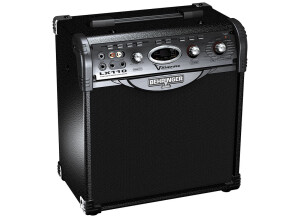
V-Ampire LX110
Modelling Combo Guitar Amp
-
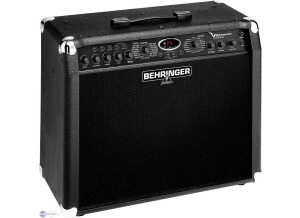
V-Ampire LX210
Modelling Combo Guitar Amp
-
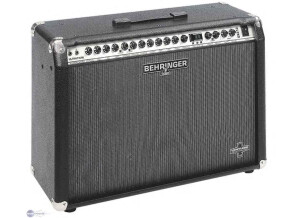
Ultratwin GX212
Modelling Combo Guitar Amp
-

Blue Devil GX112
Modelling Combo Guitar Amp
-
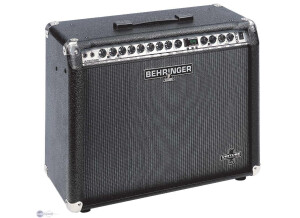
Ultratwin GX210
Modelling Combo Guitar Amp
-
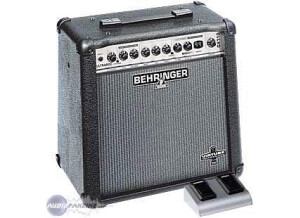
Ultraroc GX110
Modelling Combo Guitar Amp
-
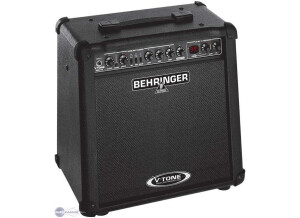
V-Tone GMX110
Modelling Combo Guitar Amp
-
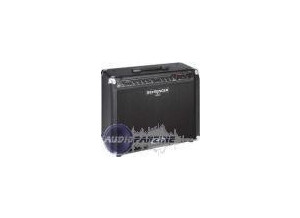
V-Tone GMX210
Modelling Combo Guitar Amp
-
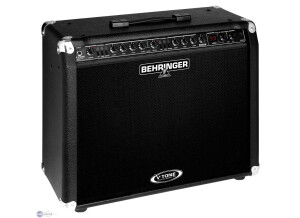
V-Tone GMX112
Modelling Combo Guitar Amp
-
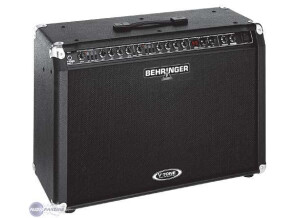
V-Tone GMX212
Modelling Combo Guitar Amp
Other categories in Guitar Combo Amplifiers
Where to buy V-Ampire LX112?
Less
There are no classified ads for this product.









